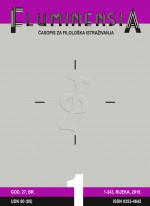ETHNOLINGUISTIC VIEW OF KLAKAR IN THE EARLY 20th CENTURY
Keywords:
Slavonian Posavina, Klakar, early 20th century, Ikavian-Jekavian dialect, material culture, phonological characteristics, morphological characteristics, syntactic characteristics, lexical characteristicsAbstract
In this paper the authors give a synthesis of linguistic (phonological, morphological, syntactic and lexical), cultural and historical facts about the Slavonian Posavian village of Klakar at the turn of the 20th century, with particular emphasis on the material culture. The ethnic identity is linked to the historical development of the community based on the unity of the territory and language. Non-linguistic facts – historical, demographic and other, such as large (historical) migrations of the population or coexistence of multiple ethnic groups in the same territory – affect the linguistic peculiarities, so if we speak, for example, about the linguistic identity in the historical continuum that includes changes, it cannot be separated from the community that recognizes it as a part of its cultural life. Ethnological, historical and linguistic research was conducted on a corpus of unpublished ethnographic manuscripts that was created by a Klakarian teacher Luka Lukić (completed in 1913) and mainly dealt with the material culture (houses, buildings, tools, etc.), whose interrelations and influence are especially noticeable in the lexis. As a result, this segment has received more attention during analysis. The interdisciplinary lexical analysis shows that, in addition to the primary Slavic lexical layer, Ottoman-Turkish, German and Hungarian cultural and linguistic supra-layers also exist, as shown by the cultural-genetic and cultural-geographical analysis of this micro-community, where the language was observed as an ethnic cultural element. On the basis of the assumptions about the linguistic and territorial cohesion, conclusions about cultural-historical-linguistic homogeneity and/or diversity are given. The methodology that was applied is interdisciplinary and includes ethnological, historical and dialectological analysis of the topics.

